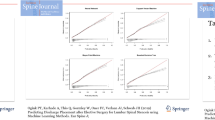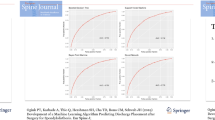Abstract
Study Design
Cross-sectional database study.
Objective
To train and validate machine learning models to identify risk factors for complications following surgery for adult spinal deformity (ASD).
Summary of Background Data
Machine learning models such as logistic regression (LR) and artificial neural networks (ANNs) are valuable tools for analyzing and interpreting large and complex data sets. ANNs have yet to be used for risk factor analysis in orthopedic surgery.
Methods
The American College of Surgeons National Surgical Quality Improvement Program (ACS-NSQIP) database was queried for patients who underwent surgery for ASD. This query returned 4,073 patients, which data were used to train and evaluate our models. The predictive variables used included sex, age, ethnicity, diabetes, smoking, steroid use, coagulopathy, functional status, American Society of Anesthesiologists (ASA) class >3, body mass index (BMI), pulmonary comorbidities, and cardiac comorbidities. The models were used to predict cardiac complications, wound complications, venous thromboembolism (VTE), and mortality. Using ASA class as a benchmark for prediction, area under receiver operating characteristic curves (AUC) was used to determine the accuracy of our machine learning models.
Results
The mean age of patients was 59.5 years. Forty-one percent of patients were male whereas 59.0% of patients were female. ANN and LR outperformed ASA scoring in predicting every complication (p<.05). The ANN outperformed LR in predicting cardiac complication, wound complication, and mortality (p<.05).
Conclusions
Machine learning algorithms outperform ASA scoring for predicting individual risk prognosis. These algorithms also outperform LR in predicting individual risk for all complications except VTE. With the growing size of medical data, the training of machine learning on these large data sets promises to improve risk prognostication, with the ability of continuously learning making them excellent tools in complex clinical scenarios.
Level of Evidence
Level III.
Similar content being viewed by others
References
Cruz JA, Wishart DS. Applications of machine learning in cancer prediction and prognosis. Cancer Inform 2007;2:59–77.
Dreiseitl S, Ohno-Machado L. Logistic regression and artificial neural network classification models: a methodology review. J Biomed Inform 2002;35:352–9.
Deo RC. Machine learning in medicine. Circulation 2015;132:1920–30.
Crown WH. Potential application of machine learning in health outcomes research and some statistical cautions. Value Health 2015;18:137–40.
Youssef JA, Orndorff DO, Patty CA, et al. Current status of adult spinal deformity. Global Spine J 2013;3:51–62.
Birknes JK, White AP, Albert TJ, et al. Adult degenerative scoliosis: a review. Neurosurgery 2008;63:94–103.
Cowan JA, Dimick JB, Wainess R, et al. Changes in the utilization of spinal fusion in the United States. Neurosurgery 2006;59:15–20; discussion 15.
He H, Bai Y, Garcia EA, Li S. ADASYN: adaptive synthetic sampling approach for imbalanced learning. In: 2008 IEEE International Joint Conference on Neural Networks (IEEE World Congress on Computational Intelligence). IEEE 2008. p. 1322–8.
Blum AL, Langley P. Selection of relevant features and examples in machine learning. Artif Intell 1997;97:245–71.
Møller AM, Pedersen T, Villebro N, Munksgaard A. Effect of smoking on early complications after elective orthopaedic surgery. J Bone Joint Surg Br 2003;85:178–81.
Iorio R, Williams KM, Marcantonio AJ, et al. Diabetes mellitus, hemoglobin A1C, and the incidence of total joint arthroplasty infection. J Arthroplasty 2012;27:726–729.el.
Chen S, Anderson MV, Cheng WK, Wongworawat MD. Diabetes associated with increased surgical site infections in spinal arthrodesis. Clin Orthop Relat Res 2009;467:1670–3.
Van Esbroeck A, Rubinfeld I, Hall B, Syed Z. Quantifying surgical complexity with machine learning: looking beyond patient factors to improve surgical models. Surgery 2014;156:1097–105.
Hu Z, Simon GJ, Arsoniadis EG, et al. Automated detection of postoperative surgical site infections using supervised methods with electronic health record data. Stud Health Technol Inform 2015;216:706–10.
Sohn S, Larson DW, Habermann EB, et al. Detection of clinically important colorectal surgical site infection using Bayesian network. J Surg Res 2017;209:168–73.
Bilimoria KY, Liu Y, Paruch JL, et al. Development and evaluation of the universal ACS NSQIP surgical risk calculator: a decision aid and informed consent tool for patients and surgeons. J Am Coll Surg 2013;217:833–842.el.
Krell MM, Wilshusen N, Seeland A, Kim SK. Classifier transfer with data selection strategies for online support vector machine classification with class imbalance. J Neural Eng 2017;14:025003.
Wang Q, Luo Z, Huang J, et al. A Novel Ensemble Method for Imbalanced Data Learning: Bagging of Extrapolation-SMOTE SVM. Cornput Intell Neurosci 2017;2017:1827016.
Somani S, Di Capua J, Kim JS, et al. Comparing NIS and NSQIP: an independent risk factor analysis for risk stratification in anterior cervical discectomy and fusion. Spine (Phila Pa 1976) 2017;42:565–72.
Wang TY, Martin JR, Loriaux DB, et al. Risk assessment and characterization of 30-day perioperative myocardial infarction following spine surgery: a retrospective analysis of 1346 consecutive adult patients. Spine (Phila Pa 1976) 2016;41:438–44.
Tsai J-T, Chou J-H, Liu T-K Tuning the structure and parameters of a neural network by using hybrid Taguchi-genetic algorithm. IEEE Trans Neural Netw 2006;17:69–80.
Cios KJ, Moore GW Uniqueness of medical data mining. Artif Intell Med 2002;26:1–24.
Weber GM, Mandl KD, Kohane IS. Finding the missing link for big biomedical data. JAMA 2014;311:2479–80.
Jain AK, Chandrasekaran B. 39 Dimensionality and sample size considerations in pattern recognition practice. Handbook Stat 1982;2:835–55.
Author information
Authors and Affiliations
Corresponding author
Additional information
Author disclosures: JSK (none), VA (none), EKO (none), DK (none), WR (none), CU (none), AKH (none), JC (none), SKC (grants from Zimmer, Orthopaedic Research and Education Foundation, and Stryker, outside the submitted work).
This study was approved by the Institutional Review Board of the Icahn School of Medicine at Mount Sinai, New York, NY.
Rights and permissions
About this article
Cite this article
Kim, J.S., Arvind, V., Oermann, E.K. et al. Predicting Surgical Complications in Patients Undergoing Elective Adult Spinal Deformity Procedures Using Machine Learning. Spine Deform 6, 762–770 (2018). https://doi.org/10.1016/j.jspd.2018.03.003
Received:
Revised:
Accepted:
Published:
Issue Date:
DOI: https://doi.org/10.1016/j.jspd.2018.03.003




